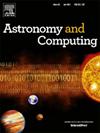Virtual realities: Is there only one advanced image display that astronomers need?
IF 1.8
4区 物理与天体物理
Q2 ASTRONOMY & ASTROPHYSICS
引用次数: 0
Abstract
Data visualisation is an essential ingredient of scientific analysis, discovery, and communication. Along with a human (to do the looking) and the data (something to look at), an image display device is a key component of any data visualisation workflow. For the purpose of this work, standard displays include combinations of laptop displays, peripheral monitors, tablet and smartphone screens, while the main categories of advanced displays are stereoscopic displays, tiled display walls, digital domes, virtual/mixed reality (VR/MR) head-mounted displays, and CAVE/CAVE2-style immersive rooms. We present the results of the second Advanced Image Displays for Astronomy (AIDA) survey, advertised to the membership of the Astronomical Society of Australia (ASA) during June–August 2021. The goal of this survey was to gather background information on the level of awareness and usage of advanced displays in astronomy and astrophysics research. From 17 complete survey responses, sampled from a population of ASA members, we infer that: (1) a high proportion of ASA members use standard displays but do not use advanced displays; (2) a moderate proportion have seen a VR/MR HMD, and may also have used one — but not for research activities; and (3) there is a need for improved knowledge in general about advanced displays, along with relevant software or applications that can target specific science needs. We expect that this is compatible with the experiences of much of the international astronomy and astrophysics research community. We suggest that VR/MR head-mounted displays have now reached a level of technical maturity such that they could be used to replicate or replace the functionality of most other advanced displays.
虚拟现实:天文学家只需要一种先进的图像显示吗?
数据可视化是科学分析、发现和交流的重要组成部分。除了人(看)和数据(看的东西),图像显示设备是任何数据可视化工作流程的关键组成部分。为了这项工作的目的,标准显示器包括笔记本电脑显示器、外围显示器、平板电脑和智能手机屏幕的组合,而高级显示器的主要类别是立体显示器、平铺显示墙、数字圆顶、虚拟/混合现实(VR/MR)头戴式显示器和CAVE/ cave2风格的沉浸式房间。我们展示了第二次高级天文图像显示(AIDA)调查的结果,该调查于2021年6月至8月向澳大利亚天文学会(ASA)的成员发布了广告。这项调查的目的是收集关于天文学和天体物理学研究中先进显示器的认识和使用水平的背景信息。从17个完整的调查回复中,从大约750名ASA成员中抽样,我们推断:(1)ASA成员中有很大比例使用标准显示器,但不使用高级显示器;(2)有中等比例曾见过或使用过VR/MR头显,但并非用于研究活动;(3)需要提高关于高级显示器的总体知识,以及针对特定科学需求的相关软件或应用程序。我们期望这与大多数国际天文学和天体物理学研究界的经验是一致的。我们认为,VR/MR头戴式显示器现在已经达到了技术成熟的水平,可以用来复制或取代大多数其他先进显示器的功能。
本文章由计算机程序翻译,如有差异,请以英文原文为准。
求助全文
约1分钟内获得全文
求助全文
来源期刊

Astronomy and Computing
ASTRONOMY & ASTROPHYSICSCOMPUTER SCIENCE,-COMPUTER SCIENCE, INTERDISCIPLINARY APPLICATIONS
CiteScore
4.10
自引率
8.00%
发文量
67
期刊介绍:
Astronomy and Computing is a peer-reviewed journal that focuses on the broad area between astronomy, computer science and information technology. The journal aims to publish the work of scientists and (software) engineers in all aspects of astronomical computing, including the collection, analysis, reduction, visualisation, preservation and dissemination of data, and the development of astronomical software and simulations. The journal covers applications for academic computer science techniques to astronomy, as well as novel applications of information technologies within astronomy.
 求助内容:
求助内容: 应助结果提醒方式:
应助结果提醒方式:


